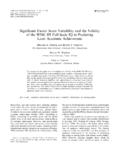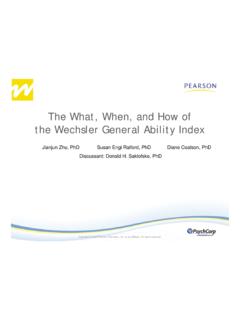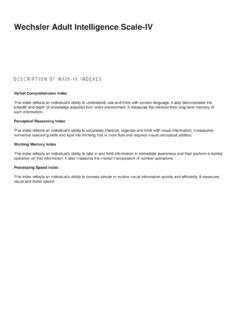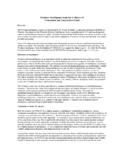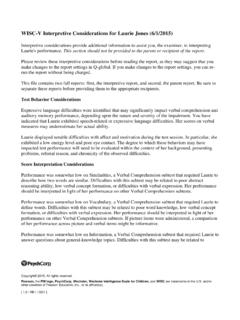Transcription of Validity of the Full-Scale I Q When There Is Significant ...
1 Applied Neuropsychology 2007, Vol. 14, No. L 13-20 Copyrightf 2007 by Lawrence Erlbaum Associates, Inc. Validity of the Full-Scale I Q When There Is Significant Variability Among WISC-III and WISC-IV Factor Scores Marley W. Watkins Pennsylvania State University, University Park, Pennsylvania, USA Joseph J. Glutting University (~l Delaware, NelVark, Delaware, USA Pui-Wa Lei Pennsylvania State University, University Park, Pennsylvania, USA Fiorello et al. (this issue) asserted that as subtest or factor-score variability increases, the overall ability score becomes a less viable predictor ol achievement--and that this is especially the casefor clinical populations. The present study tested the contention that glo-bal IQ scores are invalid predictors of achievement in the presence olsign(licant variahility among constituent factors.))
2 It did so using three samples of participants: (a) 412 from the WISC-Ill/WIAT linking sample, (b) 460 enrolled in special education programs, and (c) 136 from the WISC-IV / WIAT-II linking sample. In each sample, participants with and withollt statistically Significant factor score variability were matched on Full Scale IQ ( FSI Q), age, gender, and race/ethnicity. The special education sample lVas also matched on disability category. For all samples, the FSIQ lras a Significant predictor ofperformance on reading and mathematics tests, hut neither factor score variahility nor the interaction ol the FSIQ andfactor score variability made a statistical~r Significant incremental contrihution to the prediction (~lreading and mathematics scores.)
3 Thus, the FSIQ was a rohust predictor of achievement ill regular and clinical samples, regardless off actor variahility. Results are discussed in terms of the diagnostic importance off actor-and suhtest-score variahility. Extensive research on IQ tests has verified the utility of general intelligence as a predictor of academic achievement (Kubiszyn et aL 2000; Lubinski, 2000). For example, the median corre-lation between global intelligence and contempor-ary achievement tests is .64 (Naglieri & Bornstein, 2003). Given this ubiquitous relationship, IQ tests are included in millions of child assessments each year (Kamphaus, Petoskey, & Rowe, 2000; Sattler, 2001), where global IQs are used as "an estimate of current and likely future academic performance" (Reschly & Grimes, 1990, p.)
4 434). However, many psychologists believe that while the global IQs are "useful summaries" (Kaufman & Lichtenberger, 2002, p. 47), they are rendered uninterpretable by Significant variability among their subcomponents (Flanagan & Kaufman, Address correspondence to Marley W. Watkins.. Pennsylvania State University, 125 CEDAR Building. University Park, PA 16802. E-mail: mwwlO(a? 13 2004; Kaufman, 1994; Lezak, 1995; Weiss, Saklofski, & Prifitera, 2003; Wolber & Carne, 2002). More radically, some authors have declared global IQs to be unreliable and invalid for predict-ing academic achievement in the presence of intra-cognitive variability (Fiorello, Hale, McGrath, Ryan, & Quinn, 2002; Hale, Fiorello, Bertin, & Sherman, 2003), and have encouraged practitioners to "never interpret the global IQ score il There is Significant scatter or score variahility" (Hale & Fiorello, 2001, p.)
5 132). This sweeping recommen-dation was based on regression communality analysis of global and factor index scores from the wechsler Intelligence Scale for Children-Third Edition (WISC-Ill; wechsler , 1991), and achieve-ment scores from the wechsler Individual Achieve-ment Test (WIAT; wechsler , 1992). Fiorello and colleagues (Fiorello, Hale, Holdnack, Kavanagh, Terrell, & Long, this issue) contend that regression communality analysis identifies the pro-portion of variance in a dependent variable that WATKINS ET AL. can be uniquely attributed to each independent vari-able. Therefore, they are '"determining the relative importance of independent variables" (PedhazuL 1997, p. 243), an explanatory purpose for which regression communality analysis is ill suited (Cohen, Cohen, West & Aiken, 2003; Lindenberger & Potter, 1998).
6 Pedhazur (1997) declared that "the incremen-tal partitioning of variance is /lot a valid approach for determining the relative importance of variables" (p. 245) and suggested that "it is informative only for predictive research, where it can be used for decisions about which variables may be eliminated while sacrificing little in overall predictability" (p. 269). He wryly noted that "when applying commonality analysis .. for explanatory purposes, various authors refer the reader to the second edition of this book, without the slightest hint that I argued (strongly, I believe) against its use for this very purpose" (Pedhazur, 1997, p. 243). Explanatory and predictive research "involve dif-ferent research questions and study designs, different inferential approaches, different analysis strategies.
7 And different reported information" (H uberty, 2003, p. 271). "Predictive research empha-sizes practical applications, whereas explanatory research focuses on achieving a theoretical under-standing of the phenomenon of interest" (Venter & Maxwell. 2000. p. 152). Following these guidelines, employing multiple regression to identify the most parsimonious predictor(s) of achievement is appro-priate (see Glutting, Youngstrom, Ward, Ward, & Hale. 1997). but applying multiple regression to draw conclusions regarding the meaningfulness of IQ variables is inappropriatc. The latter task, deter-mining the relative proportion of common score variance among IQ subtests and factors, is best accomplished with factor analysis (Gustafsson & Undheim, 1996; McDonald.)
8 1985). not regression analysis. It might be argued that the studies conducted by Fiorello et al. (this issue, 2002) were predictive in nature and therefore communality analysis was properly applied. However, their communality analyses were not used to select the most parsi-monious predictors among the alternatives in ques-tion (FSIQ and factor scores). Rather. they treated FSIQ as the criterion measure and partitioned vari-ance among its constituent predictor factors to identify the "structure of cognitive functioning" (Fiorello et aI., this issue), an explanatory purpose for which communality analysis is unsuited (Pedhazur, 1997). 14 Regardless. practitioners are often advised that Significant variability among subtest or factor scores renders the global IQ score an inaccurate estimate of overall ability (Flanagan & Kaufman, 2004; Kaufman, 1994; Lezak, 1995; Weiss.
9 Saklofski, & Prifitera, 2003; Wolber & Carne, 2002), and, consequently. an invalid predictor of academic achievement (Gridley & Roid, 1998; Hildebrand & Ledbetter, 200 I). In those cases. psychologists are encouraged to disregard the global IQ and use factor or subtest scores to predict academic achievement. However, this hypothesis has not been directly tested. Is the global IQ a valid predictor of academic achievement among flat cognitive profiles and an invalid predictor of academic achievement when constituent scores are variable? The present study directly addressed that question. METHOD Instruments The WISC-III ( wechsler , 1991) is an individually administered test of intelligence for children aged 6 years through 16 years, 11 months that was stand,tr-dized on a nationally representative sample (N = ) closely approximating the 1988 United States Census on gender, parent education, racejethnicity, and geographic region.
10 The WISC-III has 13 individual sub tests (M = 10, SD = 3). ten standard and three supplementary, that com-bine to yield three composites: Verbal (VIQ). Performance (PIQ), and Full Scale (FSIQ) IQs (M = 100. SD = 15). In addition, the WISC-III provides four factor-based indexes: Verbal Compre-hension (VC), Perceptual Organization (PO), Free-dom from Distractibility (FD), and Processing Speed (PS) (M = 100. SD = 15). Full details of the WISC-III and its standardization are presented in wechsler (1991). Additional reliability and Validity data are provided by Sattler (200 I) as well as Zimmerman and Woo-Sam (1997). The wechsler Intelligence Scale for Children-Fourth Edition (WISC-IV; wechsler . 20(3) is a revised and updated version of the WISC-III.)
